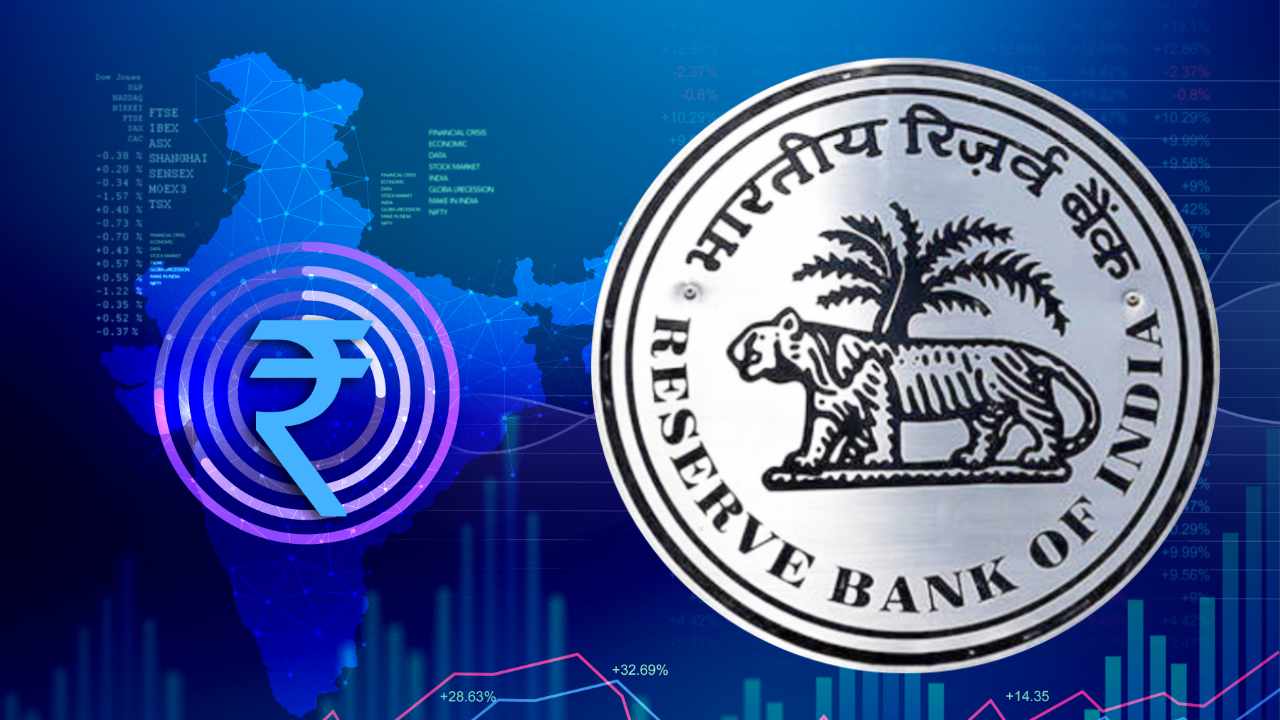Central Bank Digital Currency of India
October 7, 2023 | Expert Insights

In an effort to align itself with countries such as Australia, China, and the United States, India introduced its own central bank digital currency (CBDC), aptly named the 'Digital Rupee.' It is essentially a digital form of fiat currency.
CBDCs are still in their early stages of development, but they can potentially revolutionise how we transact. Over a million consumers and 262,000 merchants rushed to register in the CBDC retail transaction pilot program as of June this year. This could become the next big thing in digital transactions in India after the India Stack.
Background
Digital currencies have emerged as a significant force in the rapidly evolving modern financial landscape. Existing solely in digital form, these currencies are altering how financial transactions are conducted, with potential advantages and disadvantages that merit investigation. The Digital Rupee is a noteworthy development among various digital currencies, including cryptocurrencies and central bank digital currencies (CBDCs).
It is important to distinguish the Digital Rupee from cryptocurrencies. While CBDCs, like the Digital Rupee, are legal tender issued by central banks, cryptocurrencies lack an issuer and are not recognised as traditional money or currency.
One year back, the Reserve Bank of India launched pilots of CBDC in both the Wholesale and Retail segments based on blockchain technology. The pilot in the wholesale segment, known as the Digital Rupee -Wholesale (e₹-W), was launched on November 1, 2022, with the use case being limited to the settlement of secondary market transactions in government securities. Using (e₹-W) is expected to make the interbank market more efficient. Settlement in central bank money would reduce transaction costs by pre-empting the need for settlement guarantee infrastructure or for collateral to mitigate settlement risk. The retail segment pilot, digital Rupee-Retail (e₹-R), was launched on December 01, 2022, within a closed user group (CUG) comprising participating customers and merchants.
By the end of June this year, the retail CBDC project with 13 participating banks had over a million users and nearly 200,000 merchants, making it one of the world's largest CBDC projects after China. As per press reports, the RBI wants to accelerate the use of CBDC in the wholesale and retail market to nearly one million daily CBDC transactions by the end of 2023.

Analysis
CBDCs, extolled by industry experts as transformative catalysts, are poised to reshape the financial inclusion landscape. They provide a more secure and inexpensive means for people of all backgrounds to engage in economic transactions. This digital evolution grants unbanked individuals access to the formal financial system, thereby empowering them. CBDCs have the potential to transform lives because, in addition to facilitating microtransactions, they provide financial independence, encourage savings, and integrate users into the broader banking framework.
Importantly, CBDCs utilise the solid foundation of blockchain technology, utilising encryption and decentralised ledgers to strengthen financial transactions. This inherent security not only protects individuals from fraud and cyber threats but also inspires the unbanked and underbanked to actively participate in the digital economy by fostering their confidence.
CBDCs are intrinsically cost-effective, removing financial barriers and providing a low-cost means of conducting transactions, particularly for those with limited access to currency. According to the chief executive officer of the financial technology company Grip, CBDCs are the key to a more inclusive financial landscape. They empower individuals who have been excluded from the formal financial system for a long time, paving the way for a future in which access to financial services is not a privilege but a fundamental right. CBDCs hold the promise of an unlimitedly prosperous economic landscape.
Finance Minister Nirmala Sitharaman emphasised the significance of CBDCs in India when she announced their inclusion in the Union Budget 2022-23. India's commitment to the digital transformation of its financial ecosystem was cemented by the swift ratification of the Finance Bill 2022, which made necessary amendments to the pertinent section of the RBI Act of 1934.
As the Digital Rupee pilot gains traction and India embraces the future of digital currency, the country is at the vanguard of financial inclusion, offering its citizens a more accessible, secure, and cost-effective path to economic participation. The RBI is taking a measured approach to CBDC, demonstrating its dedication to exhaustively examining the potential benefits and risks associated with this digital currency innovation. A recent report by PricewaterhouseCoopers (PwC) highlights several potential benefits that CBDC could bring to India, such as increased financial inclusion, decreased transaction costs, increased efficiency of cross-border payments, and improved monetary policy effectiveness.
The Governor of the Reserve Bank of India, Shaktikanta Das, has also outlined the potential benefits of CBDC, particularly in terms of facilitating cross-border remittances and expanding financial inclusion. Moreover, he has emphasised the central bank's consideration of CBDC's efficacy in addressing cryptocurrency-related challenges. The RBI's engagement with stakeholders and the ongoing pilot programs underlines the central bank's genuine commitment to exploring the possibility of introducing CBDC in India. While the RBI approaches this endeavour cautiously, a careful and thorough approach is being taken to ensure its successful implementation.
When considering CBDC's potential, it's important to weigh the advantages and disadvantages.
CBDC could foster financial inclusion, reduce transaction costs, enhance cross-border payments, and provide better control over monetary policy. CBDC's applications in India are diverse and promising. From facilitating rural-urban trade to streamlining remittances, enabling small businesses to accept payments efficiently, and even optimising government benefits distribution, CBDC has the potential to transform financial transactions across the nation. As India moves forward with CBDC adoption, it stands on the cusp of a financial revolution with the potential to drive positive change in its financial landscape.
However, it also poses potential risks such as financial stability concerns, privacy issues, and susceptibility to fraud and cyberattacks. As India progresses in its CBDC journey, addressing these risks will be pivotal to its success. As per Fitch Ratings, these developments could also risk "double-spending" on CBDCs and push security costs, such as conducting know-your-customer checks from banks to the RBI or other entities, depending on the implementation approach. The government has demonstrated a willingness to bear costs to improve the payments infrastructure, partly because it can help improve tax compliance. A successful use case is the UPI, where no fees were levied on any transactions until March 2023, with the RBI (and banks) absorbing the cost. However, as the Indian retail CBDC grows in scale, it is bound to face challenges in reconciling security with scalability, a challenge that other markets are also facing.
Around the world, governments and central banks are exploring the potential of digital currencies. Several countries, such as the Bahamas, Nigeria, China, and Russia, have already launched or are in the process of implementing their digital currencies.
The landscape of digital currencies continues to evolve rapidly, with profound implications for financial systems and transactions. As central banks like the Reserve Bank of India delve into the realm of digital currencies, the Digital Rupee and its counterparts are poised to redefine the way we perceive and use money in the digital age.
Assessment
- The introduction of the 'Digital Rupee' CBDC has the potential to significantly alter India's economic landscape. Considering that over one million users and thousands of merchants have already registered for the pilot, it is evident that CBDC has attracted considerable interest.
- Assessing the CBDC's capacity to increase financial inclusion and decrease transaction costs, particularly in a country as diverse and economically diverse as India, will be crucial for determining its long-term impact on the financial sector.
- CBDC promises to improve financial inclusion, streamline payments, and increase the efficacy of monetary policy, but it also poses risks such as financial stability and privacy concerns. Evaluation of India's plans for mitigating these risks and ensuring a secure and effective CBDC system is crucial.








Comments